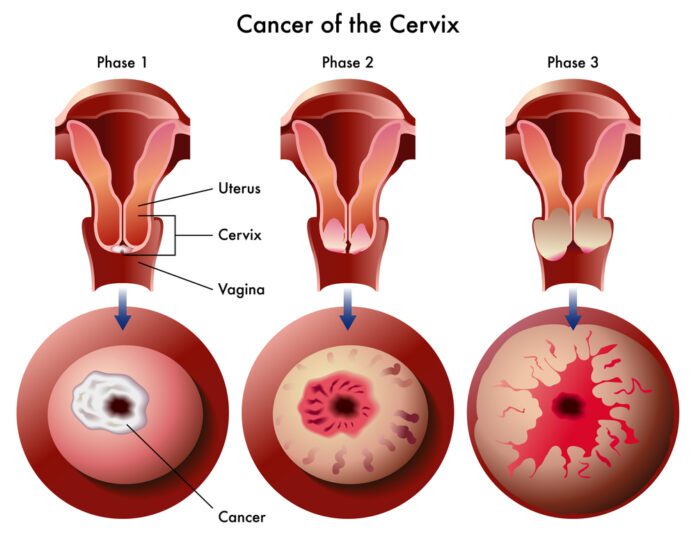Overview Of Cervical Cancer
Cervical cancer develops in a woman’s cervix (the entrance to the uterus from the vagina).
Almost all cervical cancer cases (99%) are linked to infection with high-risk human papillomaviruses (HPV), an extremely common virus transmitted through sexual contact.
Although most infections with HPV resolve spontaneously and cause no symptoms, persistent infection can cause cervical cancer in women.
Effective primary (HPV vaccination) and secondary prevention approaches (screening for, and treating precancerous lesions) will prevent most cervical cancer cases.
When diagnosed, cervical cancer is one of the most successfully treatable forms of cancer, as long as it is detected early and managed effectively. Cancers diagnosed in late stages can also be controlled with appropriate treatment and palliative care.
With a comprehensive approach to prevent, screen, and treat, cervical cancer can be eliminated as a public health problem within a generation.
Causes Of Cervical Cancer
Worldwide, cervical cancer is the third most common type of cancer in women. It is much less common in the United States because of the routine use of Pap smears.
Cervical cancer starts in the cells on the surface of the cervix. There are two types of cells on the surface of the cervix, squamous and columnar. Most cervical cancers are from squamous cells.
Cervical cancer usually develops slowly. It starts as a precancerous condition called dysplasia. This condition can be detected by a Pap smear and is nearly 100% treatable. It can take years for dysplasia to develop into cervical cancer. Most women who are diagnosed with cervical cancer today have not had regular Pap smears, or they have not followed up on abnormal Pap smear results.
Almost all cervical cancers are caused by human papillomavirus (HPV). HPV is a common virus that is spread through skin-to-skin contact and also by sexual intercourse. There are many different types (strains) of HPV. Some strains lead to cervical cancer. Other strains can cause genital warts. Others do not cause any problems at all.
A woman’s sexual habits and patterns can increase her risk of developing cervical cancer. Risky sexual practices include:
- Having sex at an early age
- Having multiple sexual partners
- Having a partner or many partners who take part in high-risk sexual activities
Other risk factors for cervical cancer include:
- Not getting the HPV vaccine
- Being economically disadvantaged
- Having a mother who took the drug diethylstilbestrol (DES) during pregnancy in the early 1960s to prevent miscarriage
- Having a weakened immune system
Symptoms Of Cervical Cancer
Most women do not have any signs or symptoms of a precancer. In many women with early-stage cervical cancer, symptoms do typically appear. In women with advanced and metastatic cancers, the symptoms may be more severe depending on the tissues and organs to which the disease has spread. The cause of a symptom may be a different medical condition that is not cancer, which is why women need to seek medical care if they have a new symptom that does not go away.
Any of the following could be signs or symptoms of cervical cancer:
•Blood spots or light bleeding between or following periods
•Menstrual bleeding that is longer and heavier than usual
•Bleeding after intercourse, douching, or a pelvic examination
•Increased vaginal discharge
•Pain during sexual intercourse
•Bleeding after menopause
•Unexplained, persistent pelvic and/or back pain
Treatment Of Cervical Cancer
Treatment for cervical cancer depends on how far cancer has spread.
As cancer treatments are often complex, hospitals use multidisciplinary teams (MDTs) to treat cervical cancer and tailor the treatment program to the individual.
MDTs are made up of several different specialists who work together to make decisions about the best way to proceed with the treatment.
The cancer team will recommend what they think the best treatment options are, in most cases, the recommendations will be:
- for early cervical cancer – surgery to remove the cervix and some or all of the womb, or radiotherapy, or a combination of both
- for advanced cervical cancer – radiotherapy with or without chemotherapy, and surgery is also sometimes used
- Cervical cancer is often curable if it’s diagnosed at an early stage.
- When cervical cancer is not curable, it’s often possible to slow its progression, prolong lifespan and relieve any associated symptoms, such as pain and vaginal bleeding. This is known as palliative care.
Other
KEY POINTS
Cervical cancer is a disease in which malignant (cancer) cells form in the tissues of the cervix.
Human papillomavirus (HPV) infection is a major risk factor for cervical cancer.
There are usually no signs or symptoms of early cervical cancer but it can be detected early with regular check-ups.
Signs and symptoms of cervical cancer include vaginal bleeding and pelvic pain.
Tests that examine the cervix are used to detect (find) and diagnose cervical cancer.
Source
https://www.who.int/health-topics/cervical-cancer
https://www.cancer.net/cancer-types/cervical-cancer/symptoms-and-signs
https://www.uhhospitals.org/services/cancer-services/gynecological-cancer/cervical-cancer/about-cervical-cancer
https://www.cranleighgardensmc.co.uk/cervical-cancer/conditions/cervical-cancer/treatment/
https://www.nhs.uk/conditions/cervical-cancer/treatment/



